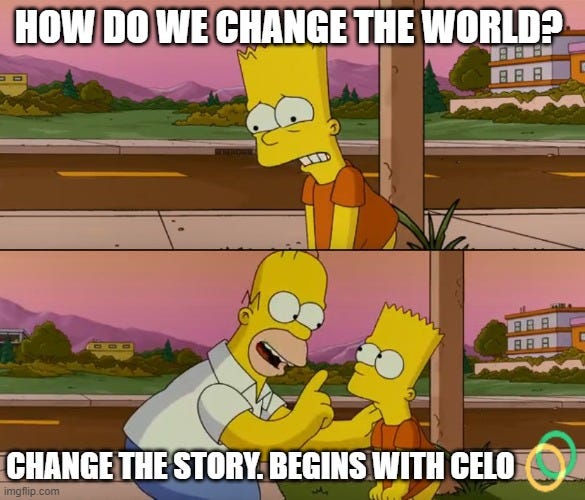Banking the Unbanked: Celo Overview
Did you know that only 1/3 of the world’s population is banked? The big question is what happens to the rest of the population. Mobile…
Did you know that only 1/3 of the world’s population is banked? The big question is what happens to the rest of the population. Mobile devices have been fronted as one of the solutions that can help bridge this gap.
Celo seeks to provide financial services to everyone with a basic smartphone.
Celo is a blockchain protocol that seeks to address hindrances to crypto-asset adoption, such as volatility and user experience.
The Celo network supports decentralized apps (dApps) and smart contracts. The Celo Wallet, the first-ever application built on the Celo network, is a social-payments system centered around smartphones.
System Architecture
Celo makes it possible for users to send cryptocurrencies using mobile phone numbers instead of managing complex crypto addresses. Even if the sender does not have the Celo app, Sending Celo Dollars is possible. The same protocol allows users to make crypto payments using WhatsApp. However, the recipient must download the app to access the funds.
Once you open a Celo account, you link a telephone number to a certain address, and after that, the phone numbers’ cryptographic hash is stored on the blockchain. Once you connect your mobile number with the app, you will receive an invite code through SMS, which you must input to synchronize your number. The app will then send three messages to verify the synchronization further. You can as well connect several numbers to the same Celo account.
A small fee is charged when verifying the numbers. The good news is that the testnet gives Celo Dollars to experiment with the app.
What is the problem with current protocols?
Ethereum is an awesome protocol that has unlocked many use cases of blockchain technology. However, when it finally transitions to a proof-of-stake algorithm, the cost of operating a node will be 32 ether.
It even gets better when we look at protocols such as Cosmos, Tezos, and Algorand that use PoS. Running a competitive Cosmos validator will cost a user over $20,000 for equipment, more than $2,000 in fees per month, and a stake of 10,000 ATOM tokens.
Celo also functions as a light client. Every time a user transacts, the light client selects the cheapest and highest-latency node to confirm the transaction. Fees charged on the network are included on the transactions sent to the full nodes, and each of the full nodes selects the minimum fee to process a transaction. As a result, the efficiency of the network increases with the rise in full nodes.
Running nodes and becoming a validator on Celo
Celo is based on the Go implementation of Ethereum and uses Proof-of-stake as its consensus algorithm. The protocol has both nodes and validators, which help verify transactions and secure the network. Celo’s PoS is not resource-intensive, but a computer with 8GB RAM, 256 SSD storage, and a Quad-Core, 3 GHz processor is desired to run Validator and proxy nodes.
A validator. These are computers that help secure the network by participating in the proof-of-stake protocol. These Validators are then grouped into Validator Groups, simply an ordered list of Validators.
Run a Full Node. Full nodes bridge the validator nodes and the mobile wallets (which run as light clients). Despite Celo being a PoS protocol, users can earn crypto by simply running a Full Node even if they haven’t staked any tokens.
Tokenomics and Governance
Holders of $CELO can use their holdings to pay gas fees as they transact on the platform. The Celo protocol establishes a gas price minimum that applies to all contract or transaction executions.
The Celo Community Fund gets a part of these gas fees (known as the base fees), which are used for the general upkeep of the Celo platform. Holders of $CELO also utilize their holdings to vote on governance.
The number of CELO tokens, previously known as $cGLD, is capped at 1 billion. Six hundred million of these tokens, while the rest are released in epoch rewards to validators and the rest to Community Fund.
Stablecoin
Stability on the Celo system relies upon the two different types of tokens available on the platform. First, the elastic supply of stablecoins pegged to fiat currencies such as Celo Euro (cEUR) and Celo Dollar (cUSD). The second token is CELO with a fixed supply and doubles as a utility and governance token. Through the dual-token system, Celo stablecoins maintain their peg with fiat currencies by adjusting the demand and supply for the CELO token.
The platform employs an extra safety mechanism where it holds a basket of diversified cryptocurrencies to support the peg. The market participants contribute to maintaining the Celo Dollar price aligned to the parity by essentially taking arbitrary profits when deviations occur. Through the Mento mechanism, holders of CELO tokens can exchange one Celo Dollar with a dollar worth of CELO.
When demand for Celo Dollar rises and pushes the price above the market rate, then an arbitrage profit is achievable by swapping one Celo Dollar with a dollar worth of CELO and then selling that Celo Dollar for the market price. The opposite happens when the demand for Celo Dollar falls and pushes the price below the target.
Why multiple stablecoins?
Celo seeks to meet the needs of people from different parts of the world. However, a stablecoin pegged to the Euro may be unsuitable for countries that use different fiat currencies. To solve this challenge, Celo provides a platform where the creation of different stablecoins is achievable. For instance, we already have Celo Dollar (cUSD) pegged to the US dollar and Celo Euro (cEUR) pegged to the Euro.
Each stablecoin’s stability is managed through a specific Mento mechanism. To ensure platform sustainability, Celo introduces new stablecoins through a governance process. The Proof-of-bonded-stake model is used to vote for new introductions and ensure that new assets don’t hurt the existing tokens’ stability.
Reserve pools are not the same for different stablecoins. The specific features of the stablecoin and the use cases of the particular stablecoin are some of the features that determine the reserve’s size.
Mission and Alliance for Prosperity
The Celo Foundation, the non-profit part of Celo, unveiled Alliance for Prosperity in March 2021. The alliance brought together more than 50 organizations to leverage Celo’s blockchain tech to bring financial inclusion to the unbanked. Alliance members have different skills and capabilities and pursue a diverse set of use cases. The members are drawn from other sectors like technology providers, mobile wallets, global investment firms, and nonprofits.
The members can either build or deploy dApps using the Celo blockchain. The decentralized apps are custom-made for mobile phones and can reach the unbanked, refugees, and neglected population. According to the alliance, Celo Dollar can come in handy in cutting down the fees incurred by immigrants during remittances or even eliminating delays in payment of loans to those in need.
Make Crypto Mobile Hackathon
Celo’s Make Crypto Mobile Hackathon was launched in September 2021 to make crypto accessible and mobile for everyone. The hackathon had $5 million in prizes and attracted participation from different players to democratize digital money.
The hackathon brought forward tons of amazing projects
The following are some notable projects that were created on Celo during the hackathon:
Ceres
Ceres is a Cash In Cash Out BLR that makes it easy for people in Brazil to move crypto to fiat seamlessly. Ceres focuses on UX and understandability to enable even those with limited crypto knowledge to benefit from it. Beginners can take advantage of DeFi yields based on their risk profiles.
Yanda
With this protocol, validators, traders and brokers share access to automated trading on-chain. Data legitimacy of transactions executed by various brokers through centralized exchanges is enhanced through the Yada protocol. The protocol also ensures that frauds never go undetected.
Revo
With this protocol, users can exchange any ERC 20 token for a staked, auto compounded position in an underlying yield farm. Users are assured of reduced fees (a fraction of standard swap fees) and not forget that the onboarding process is easy.
Talent Protocol
Finding the right talent for job openings is not that easy. Talent Protocol allows users to support undiscovered talent and get rewarded as these talents grow. This Web3 platform allows talents to launch a token for their careers, and users will then back those they believe in. With this platform, users will have ‘shares’ in someone else’s career, coming with additional benefits and utility.
Go-Africa
Despite Africa having vast arable land, its agricultural productivity is one of the lowest globally. However, agriculture is a source of livelihood to more than half a billion people residing on this content. Go-Africa is a crowdfunding project that raises finances for agro-pastoral projects.
Wrapping up
Even though crypto and DeFi have positively impacted the global finance sector, the adoption is still not where it ought to be. Wallets come in handy when managing cryptocurrency payments. However, these wallets are not as immediate or easily accessible as smartphones. With more than 6 billion having access to mobile phones, Celo might be the missing link towards the widespread adoption of crypto payments.











